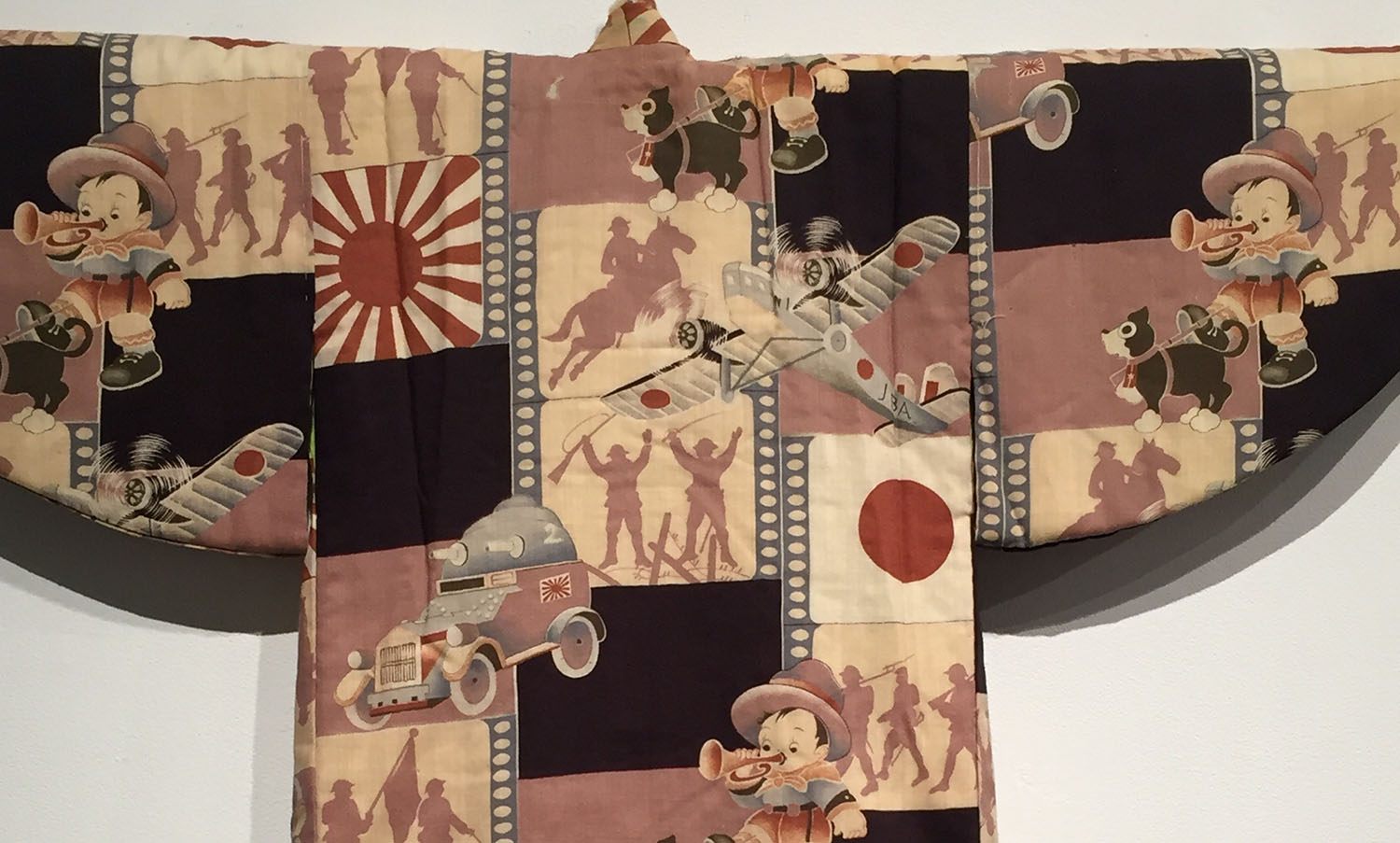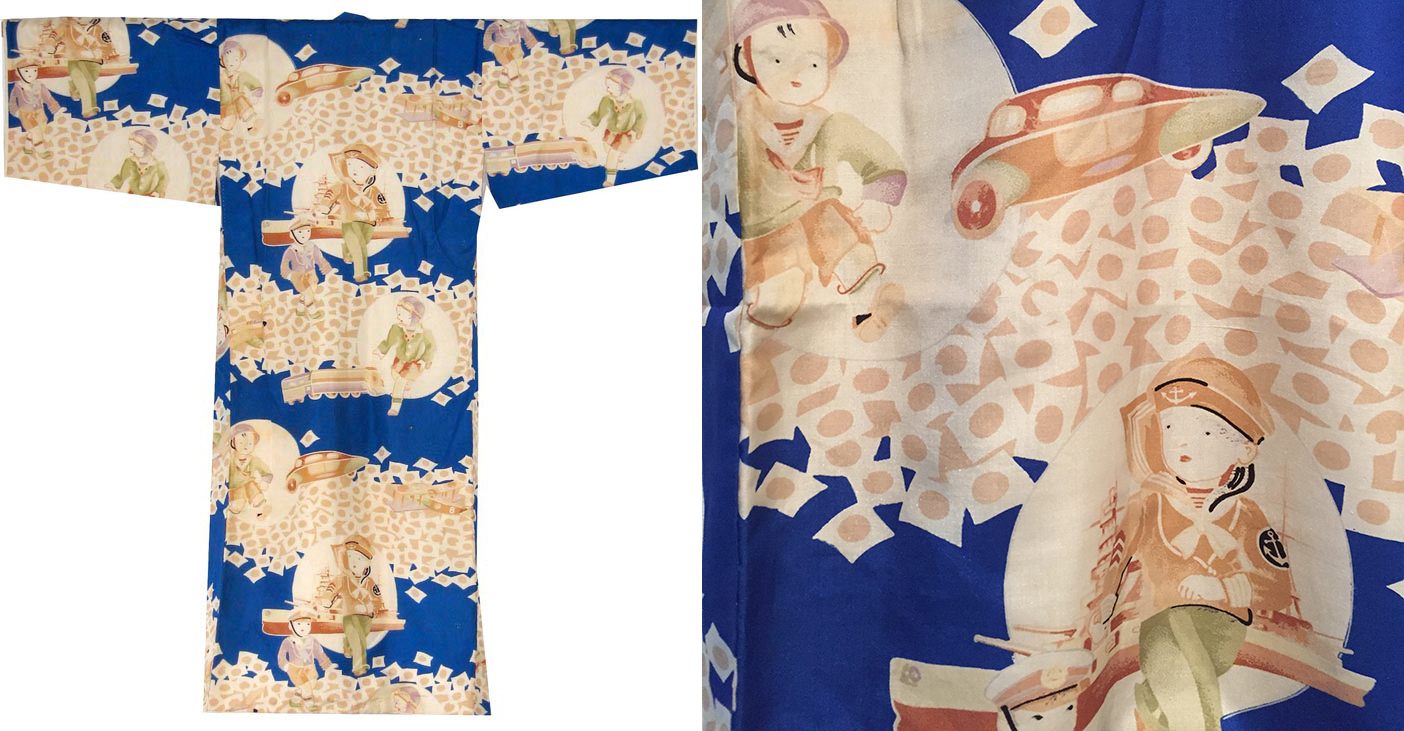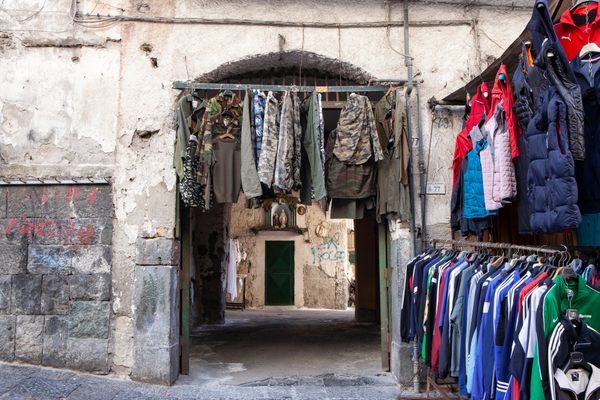The Propaganda Kimonos Japan Kept Hidden From Outsiders
These beautiful garments celebrate military power.

When you picture a Japanese kimono, you probably think of something like a haiku in clothing form. Maybe stylized scenes of chrysanthemums, long-tailed birds flying over blossoming cherry trees, or a picturesque mountain landscape. Now imagine a kimono showing two children in military gear marching to battle with their faithful puppy. How about a kimono showing Mussolini on horseback? Or one with a cute child in infantry garb with sword held aloft?
Welcome to the shocking, beautiful, fascinating world of Japanese propaganda kimonos, a form of Japanese popular art that flourished from 1900 to 1945 and has only been rediscovered in the past decade. Known as omoshirogara—literally, “interesting” or “amusing” designs—they include kimonos and other traditional Japanese apparel worn by men, women and children. This includes the nagajuban, an under-kimono; the haura, the inner lining of the haori, a kimono-like jacket; and the miyamairi kimono, the swaddling infants are dressed in for their first visit to a Shinto shrine at one month of age.
Propaganda kimonos first appeared at the end of the 19th century as Japanese textile manufacturers responded to society’s hunger to modernize. The stunning, vivid designs employ a broad, bold palette and show direct influences of social realism, Art Deco, Dadaist and Cubist collage, early cartoons, and other graphic media. Indeed, the images often appeared on other media as well – matchbook covers, posters, magazines and Japan’s first movies. Bright as the designs were, propaganda kimonos were mainly reserved for inside the home or at private parties. Since the designs were often on undergarments or linings, a host would show them off to small groups of family or friends.

Typical omoshirogara designs from the early 1920s to the late 1930s depicted a bright, Westernized, consumerist future – cityscapes with subways and skyscrapers, ocean liners, steaming locomotives, sleek cars, and airplanes. To judge by popular graphics, Japan’s bright young things, “modan garus” and “modan boyiis,” followed Hollywood fashions and knew about jazz. A new spirit was in the air. Japanese women entered the workforce; Western dress and hairstyles were in vogue.
This period of optimism was short lived, however. By the later 1920s, conservative and ultra-nationalist forces in the military and government elites began to push back, reasserting more traditional values. Military power, the will to use it, and the ability to manufacture its hardware became ever more central to Japan’s self-image. “This was a period in Japan when militarism was synonymous with modernization,” says Rhiannon Paget, co-curator with Philip Hu of “Conflicts of Interest: Art and War in Modern Japan,” a stunning exhibit that opened in October at the St. Louis Art Museum. The show includes woodblock prints, posters, magazines, and other printed artifacts, as well as kimonos. The dominant themes of the show illustrate Paget’s point – Japanese leaders had only to look in their backyard to see the benefits of military action. The British had taken Hong Kong, the Dutch were in Indonesia, Russia had advanced into Manchuria, the United States had taken over in the Philippines and had annexed Hawaii, and Germany had moved into New Guinea and Samoa.
Japan countered with its own expansion, invading Manchuria in 1931 and installing a puppet regime there. Historians agree that this marked the beginning of Japan’s descent into militaristic nationalism and aggression and its increasing isolation from the West. By the end of the decade, Japan’s only Western friends were its future Axis partners, Germany and Italy.

The propaganda kimonos adapted, combining nationalist themes with popular culture iconography. A child’s kimono (1933) shows an adorable boy in a sailor suit surrounded by a gunboat, a biplane, a sleek automobile drawn directly from a Raymond Lowey design, and an assortment of friends in kiddie versions of military uniforms.
Dogs were recurring figures, as they embodied loyalty and bravery. One recurring canine icon was Norakuro, a black and white dog who began life as a manga character in 1931, before he appeared on a 1933 kimono. Norakuro is seen with his trusty friend, against a backdrop of armored vehicles, planes, and surrendering enemy soldiers. The image even features the white-on-gray sprockets of a motion picture newsreel.

The story of the Three Brave Bombers was repeated in multiple graphic forms in 1930’s Japan. The bombers were three real-life young soldiers who died in action while laying explosives to clear out the enemy’s barbed wire defenses. Their exploits endured in film, drama, magazines graphics—and in numerous kimono designs.
Japan’s military action in Manchuria and eastern China became more brutal through the 1930s, culminating in the Massacre of Nanking, which generated international condemnation. In Japan, however, the fall of Nanking in 1938 was cause for celebration. Newsreel footage was adapted to make widely popular graphic representations of the victorious general, Matsui Iwane on horseback in front of the gates of the city.
Increasingly isolated, Japan forged closer ties with Fascist Italy and Nazi Germany. Kimono designers acknowledged that link repeatedly, showing, for instance, Ethiopia and Somaliland as Italian colonies. The detail shows the strange, startling contrast between Mussolini’s puffed up pose and the cheery innocence of the Ethiopian child in army fatigues pushing a barrow full of artillery shells. It is kitsch and chilling at the same time.

Most troubling of all are the images that supported Nazi Germany. The only defense is that these images were made in 1936-1940, before the full horror of the extermination camps was widely known in Japan. The result is a mix of the terrible and the tender. On one nagajuban (under-kimono) from 1936, a child soldier (wearing a Wehrmacht helmet) and his puppy prepare a care package for soldiers at the front. In the background a Nazi flag flutters and Panzer tanks grind forward.
The 1940 kimono celebrating the signing of the Axis Tripartite Pact shows the naval flags of Italy, Japan, and Nazi Germany. Though it seems a somewhat pro forma design compared to the usual standard, there are discordant touches of wit – steam from the chugging locomotive blends with the clouds where the Axis bombers fly, and the puffs of anti-aircraft fire resemble Japan’s traditional symbol, the chrysanthemum.

Though widely popular from the 1920s to the early 1940s, Japan’s propaganda kimonos, now viewed as a source of shame, have long been forgotten or suppressed, save by those who’d made or sold them. Their eventual rediscovery is largely the work of Jacqueline M. Atkins, an American textile historian and recognized scholar of Japanese 20th century textiles. In 1995 Atkins was a Fulbright scholar researching quilting in Japan and, as part of her research, sought out textile shops that sold used kimonos and textiles to quilters. Now and then, she came across some with militaristic designs, which intrigued her. After asking around, she was referred to a particular dealer known for her extensive collection of kimono textiles, including those with wartime designs.
After initially refusing to show Atkins and her assistant the kimonos, the woman relented and invited them to her house, where she had the kimonos stored. “She started pulling out boxes of them,” Atkins recalls. “They just floored me. I had never seen stuff like this.” When Atkins told the woman that these remarkable textiles were worthy of an exhibition, the woman flatly refused.
Atkins returned to the U.S. to complete her monograph on Japanese quilting, but vowed to return to the subject of these kimonos. “I became obsessed,” she says. The subject was all the more tantalizing and frustrating for having no written documentation: “I couldn’t find anything about them. Specialists in Japanese visual culture looked at me like I didn’t know what I was talking about.”

Her project on quilting completed, Atkins returned to Japan to meet with the woman who’d first shown her the trove of wartime kimonos. Through her, Atkins met other Japanese collectors. They were a secretive lot: “Many kept their collections private, never showing them. One told me, ‘My family doesn’t even know I collect these.’” It was understandable, says Atkins, “The Japanese lost the war and these kimono designs were all about victory.”
In the years following, Atkins has uncovered more than 1000 different omoshirogara designs and has contributed to two scholarly books on them. Her work on these kimonos has influenced exhibits at several museums, including the Metropolitan Museum of Art, the MFA in Boston, and the current exhibit at the St. Louis Art Museum.
Atkins approached Susan Weber, director of the Bard Graduate Center in New York, about mounting an exhibit on the kimonos. When it opened in 2005, the show, “Wearing Propaganda: Textiles on the Home Front in Japan, Britain, and the United States 1931–1945,” alerted potential collectors outside Japan that these remarkable garments existed – and could be purchased for a few hundred dollars. Today they typically cost in the thousands.

One large collector is Norman Brosterman, an art dealer living in East Hampton, New York. His collection of over 150 kimonos formed the basis of an exhibit last year at the Edward Thorp Gallery in Chelsea, from which many of the images here are taken. He has sold, donated, and loaned many kimonos to museums in the U.S.; the rest he hopes to sell. If you’d like to buy one, Brosterman is happy to oblige.
After much hesitation, Japan is also beginning to show an interest in these kimono designs. There have been a number of small exhibits devoted to them there, but no major show. Still, Atkins and others were heartened in 2015, when crown prince Naruhito, Hirohito’s grandson, stated that he felt it important to “correctly pass on the tragic experiences and history that Japan pursued” during the war years, before the participants die or their memories fade. It’s a signal, Atkins feels, that Japan is willingly turning a page.
“These kimono designs offer an extraordinary window for research into the culture of war,” says Atkins. “Although the designs are unique, their concept is not; other countries – U.S. and U.K. included – had a history of wartime textiles as well. These Japanese examples were not an isolated phenomenon but rather an integral component of the culture of their time.”






























Follow us on Twitter to get the latest on the world's hidden wonders.
Like us on Facebook to get the latest on the world's hidden wonders.
Follow us on Twitter Like us on Facebook